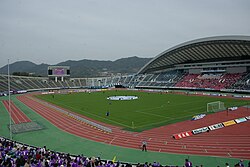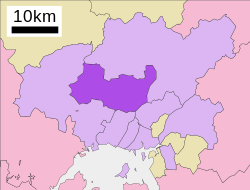Asaminami-ku, Hiroshima
広島市安佐南区 | |
|---|---|
Ward of Hiroshima | |
| 安佐南区• Asaminami-ku | |
 Hiroshima Big Arch | |
 Location of Mihama in Asaminami-ku in Hiroshima City | |
| Coordinates: 34°27′07″N 132°28′19″E / 34.45194°N 132.47194°E | |
| Country | Japan |
| Region | Chūgoku (Sanyo) |
| Prefecture | Hiroshima |
| City | Hiroshima |
| Area | |
| • Total | 117.24 km2 (45.27 sq mi) |
| Population | |
| • Total | 245,475 |
| • Density | 2,094/km2 (5,420/sq mi) |
| Time zone | UTC+9 (Japan Standard Time) |
| Postal | 731-0193 |
| Asaminami Ward Office's Address | Furuichi 1-33-14, Asaminami-ku, Hiroshima City, Hiroshima Prefecture (広島県広島市安佐南区古市1丁目33番14号) |
| Phone | 81-(0)82-831-4925, 831-4927 |
Asaminami-ku (安佐南区) is one of the eight wards of the city of Hiroshima, located in the south of former Asa District.
Asa District consisted of Gion-cho, Yasufuruichi-cho, Sato-cho, Numata-cho. After being merged with Hiroshima in 1973, this ward was named Asaminami-ku. The largest station of Astramline, a new traffic system, is in Asaminami-ku. This system brought population inflow.[citation needed]
As of January 1, 2018, the ward has an estimated population of 245,475, with 101,941 households and a density of 2094 persons per km2. The total area is 117.24 km2.[2][1]
Transportation[edit]
JR-Kabe line[edit]
Astram line[edit]
Expressway[edit]
Industry[edit]
Hiroshima Mitsubishi Heavy Industries in Gion closed its doors in 2003.
Education[edit]
- Hiroshima City University
- Hiroshima University of Economics
- Hiroshima Shudo University
- Yasuda Women's University
Agriculture[edit]
Former Sato-cho, now a part of the ward, has been a major production area for Hiroshimana since Meiji era. Hiroshimana is a variety of Chinese cabbage and is the main material used for making Hiroshimanazuke (literally "pickled Hiroshimana").[3][4][5]
Landslide[edit]
In August 2014 many people died in a landslide after very heavy rain.[6]
Footnotes[edit]
- ^ The density was calculated based on the population estimates and the total area.
References[edit]
- ^ a b "広島市 - 面積" (in Japanese). Hiroshima City. Archived from the original on April 26, 2017. Retrieved February 5, 2018.
- ^ a b "広島市 - 推計人口" (in Japanese). Hiroshima City. Archived from the original on February 6, 2018. Retrieved February 5, 2018.
- ^ "佐東(さとう)とは - コトバンク". kotobank (in Japanese). Retrieved February 5, 2018.
- ^ "広島菜(ヒロシマナ)とは - コトバンク". kotobank (in Japanese). Retrieved February 5, 2018.
- ^ Mikami Shousou (1998). 広島菜栽培地域川内地区の経済地理学的研究. 広島経済大学研究双書 (in Japanese). Hiroshima University of Economics. pp. 6–9. JPNO 99107788.
- ^ "Japan landslides: deaths confirmed after homes swept away". the Guardian. August 20, 2014.


Well, that’s interesting to know that Psilotum nudum are known as whisk ferns. Psilotum nudum is the commoner species of the two. While the P. flaccidum is a rare species and is found in the tropical islands. Both the species are usually epiphytic in habit and grow upon tree ferns. These species may also be terrestrial and grow in humus or in the crevices of the rocks.
View the detailed Guide of Psilotum nudum: Detailed Study Of Psilotum Nudum (Whisk Fern), Classification, Anatomy, Reproduction